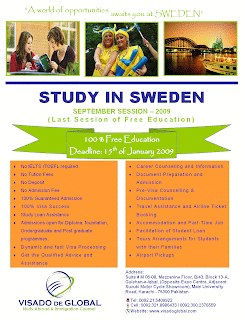Education in Sweden is compulsory for all children aged 7 to 16 years. The child can be admitted to kindergarten on the first birthday of the child. The school year in Sweden starts in mid-August and early and mid-June. The Christmas holidays from mid-December to early January divide the Swedish school year into two quarters. Homeschooling is prohibited unless there are "exceptional circumstances".
One year after the year of the children should not be accepted for the preschool (nursery). For the school, the help includes an environment that stimulates the development and learning of children and allows parents to combine parenting with work or studies. The financial year before children start primary school offers to all children a space in a preschool classroom, which combines preschool pedagogical methods and compulsory schooling. Between 6/7 and 15/16 years old, children attend elementary school, divided into three phases. Most schools in Sweden are the main ones, but there are also independent and publicly funded schools called "schools". Education in schools has many goals in common with the municipal school, but it has a different direction from municipal schools. a handful of boarding schools, called "private schools," funded by tuition fees paid in particular.
 A study in Sweden 2008, statistics show that all Swedes aged 15% have completed only compulsory education (the highest level of achievement), secondary education, only 46%, only 14% years of higher education in less than 3 years and 22% - Postsecondary education, 3 years or more, Women are more educated than men (26% of women versus 19% have a post-secondary education, 3 years or more). Education is highest among 25-34-year-olds and decreases with age. Secondary and university education is financed by taxes. Some Swedes go directly to work after school. Together with several other European countries, the government also allows private hours for international students in a given institution in Swedish institutions, although there has been the talk of change. Swedish students aged 15 have a higher average score 22 in the PISA assessments. significantly above or below the OECD average. only Canada, the United States, and Japan have higher levels of higher education graduates.
A study in Sweden 2008, statistics show that all Swedes aged 15% have completed only compulsory education (the highest level of achievement), secondary education, only 46%, only 14% years of higher education in less than 3 years and 22% - Postsecondary education, 3 years or more, Women are more educated than men (26% of women versus 19% have a post-secondary education, 3 years or more). Education is highest among 25-34-year-olds and decreases with age. Secondary and university education is financed by taxes. Some Swedes go directly to work after school. Together with several other European countries, the government also allows private hours for international students in a given institution in Swedish institutions, although there has been the talk of change. Swedish students aged 15 have a higher average score 22 in the PISA assessments. significantly above or below the OECD average. only Canada, the United States, and Japan have higher levels of higher education graduates.
One year after the year of the children should not be accepted for the preschool (nursery). For the school, the help includes an environment that stimulates the development and learning of children and allows parents to combine parenting with work or studies. The financial year before children start primary school offers to all children a space in a preschool classroom, which combines preschool pedagogical methods and compulsory schooling. Between 6/7 and 15/16 years old, children attend elementary school, divided into three phases. Most schools in Sweden are the main ones, but there are also independent and publicly funded schools called "schools". Education in schools has many goals in common with the municipal school, but it has a different direction from municipal schools. a handful of boarding schools, called "private schools," funded by tuition fees paid in particular.
 A study in Sweden 2008, statistics show that all Swedes aged 15% have completed only compulsory education (the highest level of achievement), secondary education, only 46%, only 14% years of higher education in less than 3 years and 22% - Postsecondary education, 3 years or more, Women are more educated than men (26% of women versus 19% have a post-secondary education, 3 years or more). Education is highest among 25-34-year-olds and decreases with age. Secondary and university education is financed by taxes. Some Swedes go directly to work after school. Together with several other European countries, the government also allows private hours for international students in a given institution in Swedish institutions, although there has been the talk of change. Swedish students aged 15 have a higher average score 22 in the PISA assessments. significantly above or below the OECD average. only Canada, the United States, and Japan have higher levels of higher education graduates.
A study in Sweden 2008, statistics show that all Swedes aged 15% have completed only compulsory education (the highest level of achievement), secondary education, only 46%, only 14% years of higher education in less than 3 years and 22% - Postsecondary education, 3 years or more, Women are more educated than men (26% of women versus 19% have a post-secondary education, 3 years or more). Education is highest among 25-34-year-olds and decreases with age. Secondary and university education is financed by taxes. Some Swedes go directly to work after school. Together with several other European countries, the government also allows private hours for international students in a given institution in Swedish institutions, although there has been the talk of change. Swedish students aged 15 have a higher average score 22 in the PISA assessments. significantly above or below the OECD average. only Canada, the United States, and Japan have higher levels of higher education graduates.
Education in Sweden | Sweden Education System
 Reviewed by SVR
on
3:46 AM
Rating:
Reviewed by SVR
on
3:46 AM
Rating:
 Reviewed by SVR
on
3:46 AM
Rating:
Reviewed by SVR
on
3:46 AM
Rating:


















